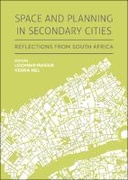Explore

Space and planning in secondary cities
0 Ungluers have
Faved this Work
Login to Fave
Much of the urban research focuses on the large metropolitan areas in South Africa. This book assesses spatial planning in the second-tier cities of the country. Secondary cities are vital as they perform essential regional, and in some cases, global economic roles and help to distribute the population of a country more evenly across its surface. Apartheid planning left South African cities fragmented segregated and with low densities. Post-apartheid policies aim to reverse these realities by emphasising integration, higher densities and upgrading. Achieving these aims has been challenging and often the historical patterns continue. The evidence shows that two opposing patterns prevail, namely increased densities and continued urban sprawl. This book presents ten case studies of spatial planning and spatial transformation in secondary cities of South Africa. The book frames these case studies against complexity theory and suggests that the post-apartheid response to apartheid planning represents a linear deviation from history. The ten case studies then reveal how difficult it is for local decision-makers to find appropriate responses and how current responses often result in contradictory results. Often these cities are highly vulnerable and they find it difficult to plan in the context of uncertainty. The book also highlights how these cities find it difficult to stand on their own against the influence of interest groups (property developers, mining companies, traditional authorities, other spheres of government). The main reasons include weak municipal finance statements, the dependence on national and provincial government for capital expenditure, limited investment in infrastructure maintenance, the lack of planning capacity, the inability to implement plans and the unintended and sometimes contrary outcomes of post-apartheid planning policies.
This book is included in DOAB.
Why read this book? Have your say.
You must be logged in to comment.
Rights Information
Are you the author or publisher of this work? If so, you can claim it as yours by registering as an Unglue.it rights holder.Downloads
This work has been downloaded 54 times via unglue.it ebook links.
- 54 - pdf (CC BY-NC) at OAPEN Library.
Keywords
- 1990–2013
- Adaptive co-evolution
- and preservation of heritage
- Architecture
- Balancing urban and rural land development
- City & town planning - architectural aspects
- Collaborative and adaptive planning and leadership
- Complex adaptive systems
- complex spaces
- Complexity as a lens to assess spatial planning instruments
- Complexity in spatial planning for Stellenbosch Municipality
- Complexity of planning in Mahikeng
- complexity theory and spatial change
- Context and changes in Matjhabeng
- Corridors and transportation
- demographics
- Drakenstein Municipality’s spatial problems
- External dynamics that hinder spatial transformation
- Factors affecting spatial change in Polokwane Local Municipality
- Gated estates
- Implications for planning in complex systems
- Infrastructure
- Integrated development
- Interconnected nodes and car-free transport
- Internal dynamics that hinder spatial transformation
- Landscape art & architecture
- Main spatial challenges
- Matjhabeng: planning in the face of the Free State Goldfields decline
- Mbombela: a growing provincial capital and tourism destination
- Mining booms and busts
- Msunduzi: spatially integrating Kwazulu-Natal’s diverse capital
- Municipal infrastructure
- N4 Maputo corridor
- Optimal land use
- Participatory Planning
- Planning for spatial transformation
- Planning in a difficult space
- Policy and planning frameworks
- Policy for spatial containment
- Post-apartheid spatial policy
- Precinct plans
- Promotion of agriculture and food production
- Quality of the spatial development framework and planning process
- realistic plans in a situation of economic stagnation
- Resource custodianship
- Secondary cities
- Secondary cities and research and policy in South Africa
- Settlement hierarchy
- Settlement planning and housing policy for mining towns
- Socioecological systems
- Spatial and population change
- Spatial change
- Spatial changes in Matjhabeng
- Spatial planning
- Spatial planning and complexity lessons
- Spatial planning for the Limpopo energy hub
- Spatial planning in Matjhabeng: 1994–2018
- Spatial planning problems in Rustenburg
- Spatial priorities and plans
- spatial transformation
- Spatial transformation and complexity
- sprawl
- The 2005/2006 spatial development framework
- The 2013 spatial development framework
- The 2015 Matjhabeng by-laws
- The arts
- the contribution of the spatial development framework to spatial transformation
- thema EDItEUR::A The Arts::AM Architecture::AMV Landscape architecture and design::AMVD City and town planning: architectural aspects
- urban sprawl
- Water and sanitation infrastructure
- Welkom’s economy and global market forces
Links
DOI: 10.18820/9781928424352Editions

